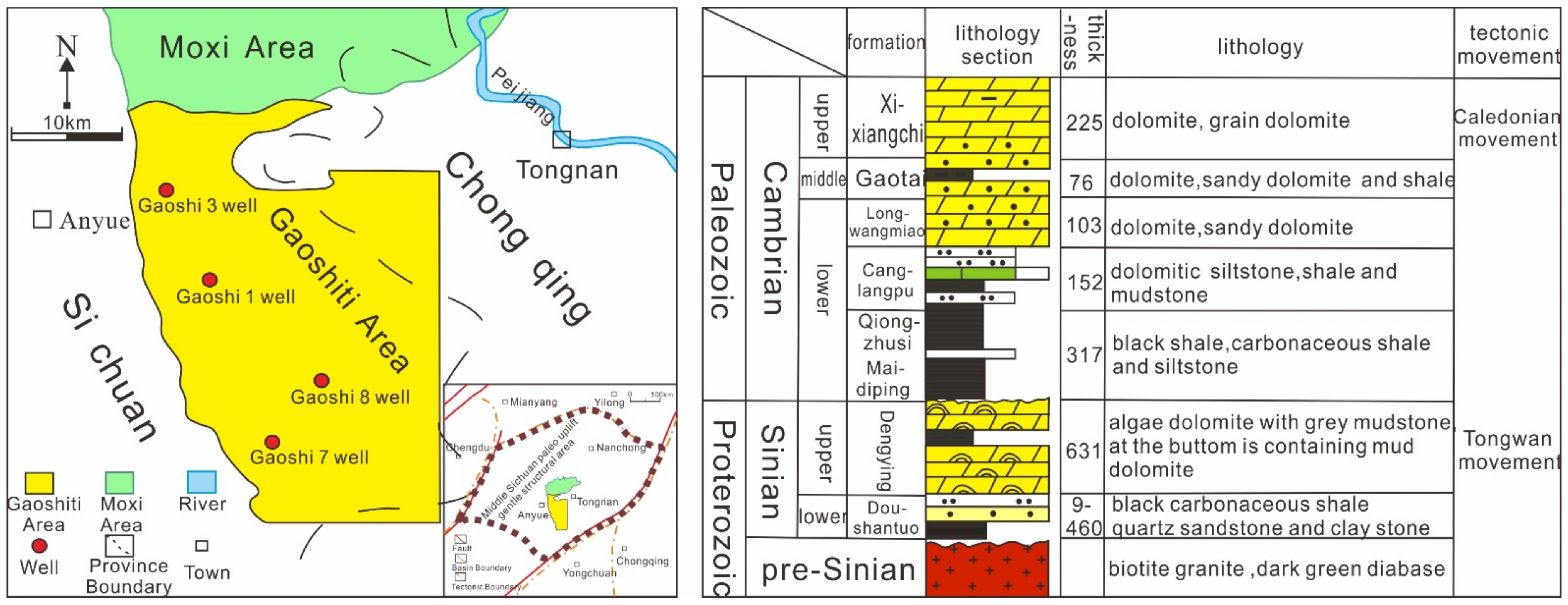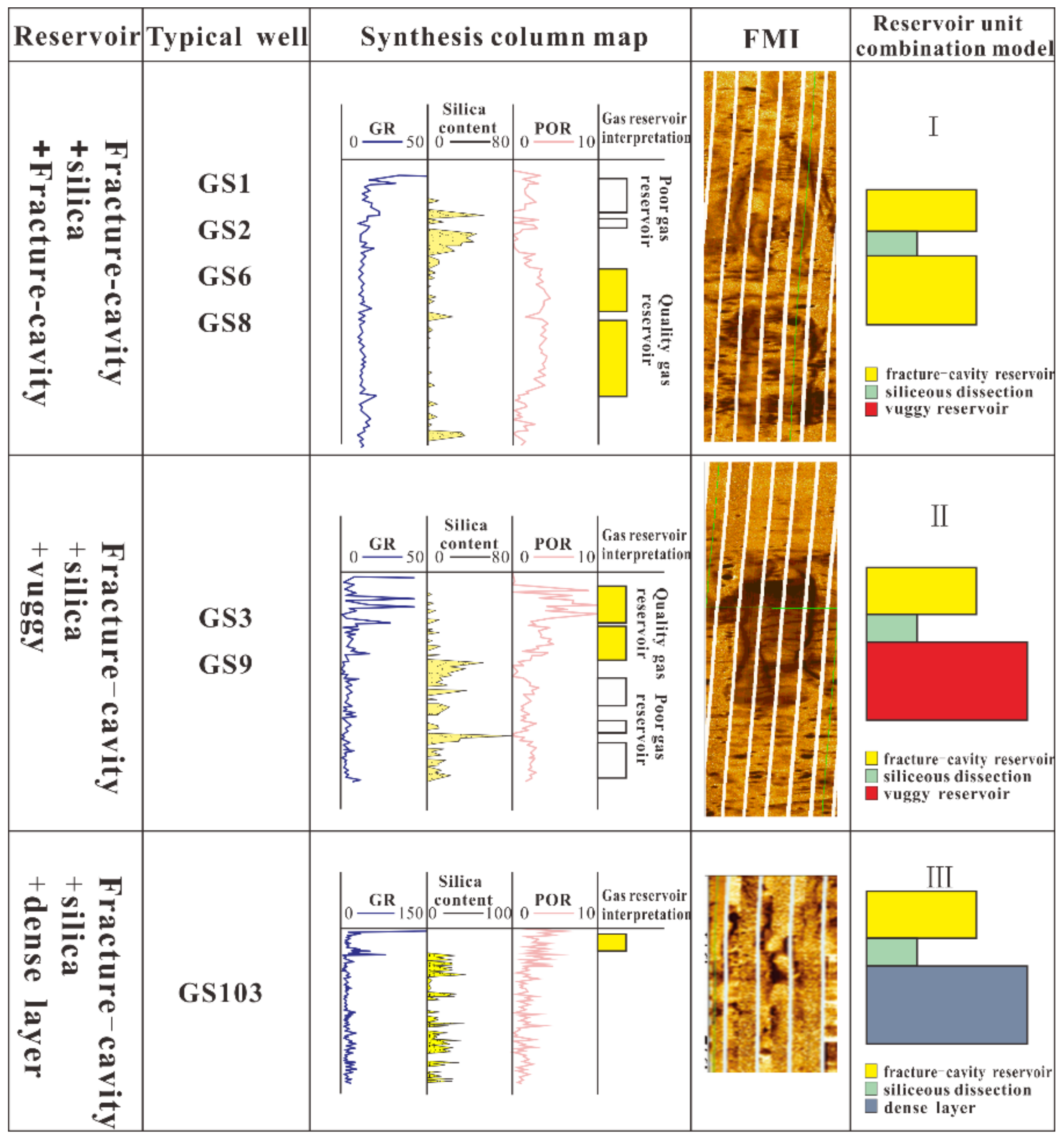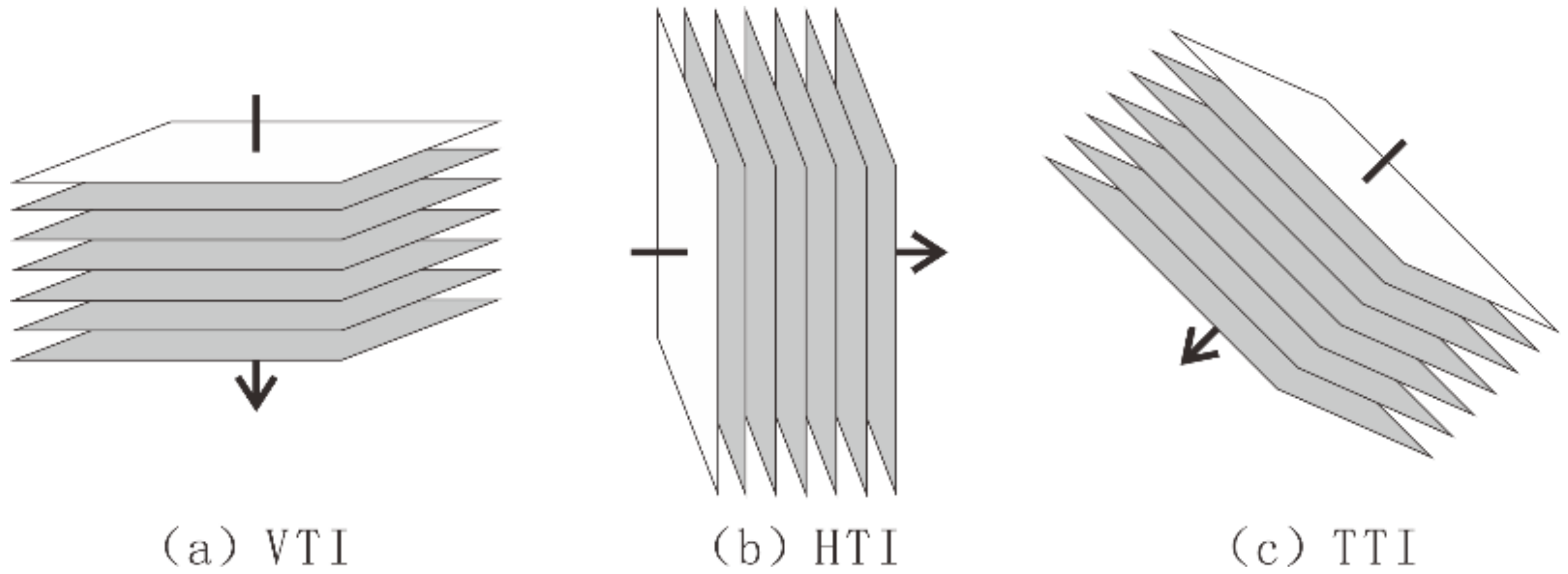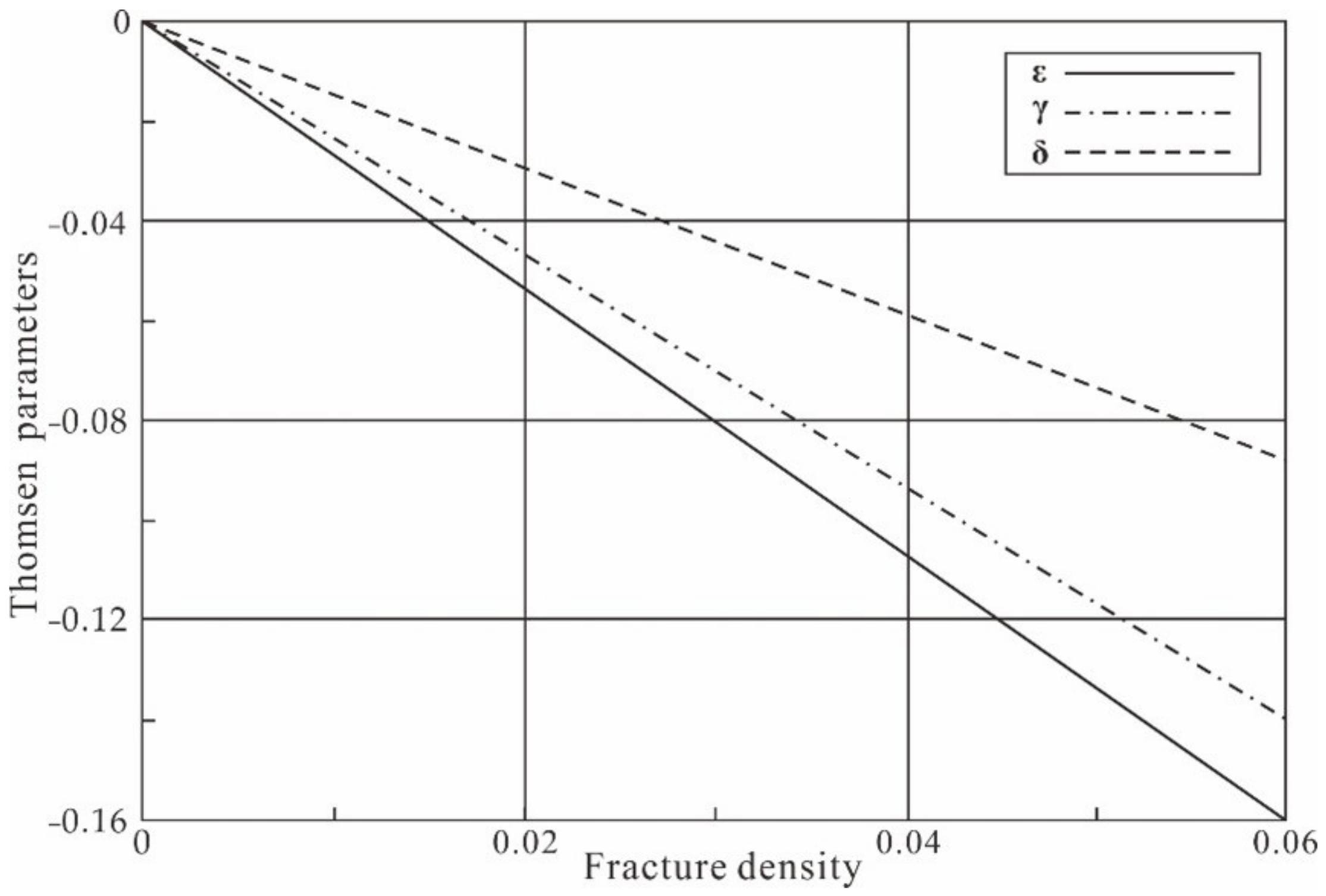Analysis of AVAZ Seismic Forward Modeling of Fracture-Cavity Reservoirs of the Dengying Formation, Central Sichuan Basin
Abstract
:1. Introduction
2. Geological Background and Building Model
2.1. Geological Facts
2.2. Characteristics of Reservoir Pore Space
2.3. Characteristics of Reservoir Vertical Combination
2.4. Construction of the Geological Model
3. Anisotropic Reflection Theory of Fracture-Cavity Reservoirs
3.1. Thomsen’s Anisotropic Parameters
3.2. Reservoir Reflection Coefficient
4. Summary and Discussion
4.1. Characteristics of Seismic Response
4.2. Characteristics of Seismic Facies
5. Conclusions
Author Contributions
Funding
Institutional Review Board Statement
Informed Consent Statement
Data Availability Statement
Conflicts of Interest
Nomenclature
| AVAZ | Amplitude Variation with Azimuth |
| AVO | Amplitude variation with offset |
| HTI | Horizontal Transverse Isotropy |
| VTI | Vertical Transverse Isotropy |
| TTI | Tilted symmetry axis Transverse Isotropy |
| Type I | fracture-cavity reservoir + siliceous strip + fracture-cavity reservoir |
| Type II | fracture-cavity reservoir + siliceous strip + cave type reservoir |
| Type III | fracture-cavity reservoir + siliceous strip + relatively dense layer |
| P-P wave | Incident p-wave to receive p-wave |
References
- Du, J.H.; Zou, C.N.; Xu, C.C.; He, H.; Shen, P.; Yang, Y. Theoretical and technical innovations in strategic discovery of a giant gas field in Cambrian Longwangmiao Formation of central Sichuan paleo-uplift, Sichuan Basin. Pet. Explor. Dev. 2014, 41, 268–277. [Google Scholar] [CrossRef]
- Yu, Z.R.; Yang, Y.; Xiao, Y.; He, B.; Song, L.; Zhang, M. High-yield well modes and production practices in the Longwangmiao Fm gas reservoirs, Anyue Gas Field, central Sichuan Basin. Nat. Gas Ind. 2016, 36, 69–79. (In Chinese) [Google Scholar] [CrossRef]
- Jiang, R.; Zhao, L.; Xu, A.; Ashraf, U.; Yin, J.; Song, H.; Anees, A. Sweet spots prediction through fracture genesis using multi-scale geological and geophysical data in the karst reservoirs of Cambrian Longwangmiao Carbonate Formation, Moxi-Gaoshiti area in Sichuan Basin, South China. J. Pet. Explor. Prod. Technol. 2022, 12, 1313–1328. [Google Scholar] [CrossRef]
- Ullah, J.; Luo, M.; Ashraf, U.; Pan, H.; Anees, A.; Li, D.; Ali, J. Evaluation of the geothermal parameters to decipher the thermal structure of the upper crust of the Longmenshan fault zone derived from borehole data. Geothermics 2020, 98, 102268. [Google Scholar] [CrossRef]
- Ashraf, U.; Zhang, H.; Anees, A.; Nasir, M.H.; Ali, M.; Ullah, Z.; Zhang, X. Application of unconventional seismic attributes and unsupervised machine learning for the identification of fault and fracture network. Appl. Sci. 2020, 10, 3864. [Google Scholar] [CrossRef]
- Ashraf, U.; Zhang, H.; Anees, A.; Ali, M.; Zhang, X.; Shakeel, A.S.; Nasir, M.H. Controls on reservoir heterogeneity of a shallow-marine reservoir in Sawan gas field, SE Pakistan: Implications for reservoir quality prediction using acoustic impedance inversion. Water 2020, 12, 2972. [Google Scholar] [CrossRef]
- Ma, L.W.; Gu, H.M.; Li, Z.J.; Lv, S.S. Simulation of carbonate fracture-cavern reservoir reflection characteristics with forward modeling. Oil Geophys. Prospect. 2015, 502, 290–297. (In Chinese) [Google Scholar]
- Sun, M.S.; Liu, C.Y.; Yang, Y.; Zhang, G.; Feng, C. The forward modeling of fracture and cave carbonate reservoirs of the Yingshan Formation in Tazhong area, Tarim Basin. Earth Sci. Front. 2017, 24, 339–349. (In Chinese) [Google Scholar]
- Ma, L.W.; Yang, Q.Y.; Gu, H.M. Simulation of reservoir seismic response in the northern slope of the middle Tarim Basin with random fracture-cavern media model. Oil Geophys. Prospect. 2016, 51, 1119–1127+1049. (In Chinese) [Google Scholar]
- Yang, P.; Sun, Z.D.; Li, H.Y. Key influence factors of Karst fracture-cave bodies on reflection characteristics. Oil Geophys. Prospect. 2015, 50, 523–529. (In Chinese) [Google Scholar]
- Bachrach, B. Uncertainty and nonuniqueness in linearized AVAZ for orthorhombic media. Lead. Edge 2015, 34, 1048–1050, 1052, 1054, 1056. [Google Scholar] [CrossRef]
- Wang, L.P.; Gu, H.M.; Li, Z.J. The characteristic analysis of AVO attribution for fractured-Vuggy reservoir model. Geol. Sci. Technol. Inf. 2011, 32, 197–201. (In Chinese) [Google Scholar]
- Chen, J.; Zhang, H.; Wang, J.; Wang, H.; Chen, F.; Meng, X. Carbonate fracture-cave reservoir prediction with prestack AVO. Pet. Geophys. Explor. 2014, 49, 1191–1198. [Google Scholar]
- Narhari, S.R.; Al-Qadeeri, B.; Dashti, Q. Application of prestack orthotropic AVAz inversion for fracture characterization of a deep carbonate reservoir in northern Kuwait. Lead. Edge 2015, 34, 1488–1493. [Google Scholar] [CrossRef]
- Liu, X.W.; Guo, Z.Q.; Liu, C. Anisotropy rock physics model for the Longmaxi shale gas reservoir, Sichuan Basin, China. Appl. Geophys. 2017, 14, 21–30. [Google Scholar] [CrossRef]
- Lu, C.; Wang, X.; Lu, X.; Zhou, Q.; Zhang, Y.; Sun, Z.; Xiao, L.; Liu, X. Evaluation of Hydrocarbon Generation Using Structural and Thermal Modeling in the Thrust Belt of Kuqa Foreland Basin, NW China. Geofluids 2020, 2020, 8894030. [Google Scholar] [CrossRef]
- Fu, X.B.; Yu, J.S.; Yuan, J.L. Modelling analysis of the limitation of P-wave AVAZ inversion. J. Appl. Geophys. 2019, 170, 103842. [Google Scholar] [CrossRef]
- Wang, C.C.; Shi, Z.J.; Hu, X.Q.; Chen, H. Geophysical response and formation mechanism analysis of fractured-vuggy reservoir in Maokou formation in southeast Sichuan. Prog. Geophys. 2011, 26, 1683–1689. (In Chinese) [Google Scholar]
- Xiao, F.S.; Chen, K.; Ran, Q.; Zhang, X.; Xie, B.; Liu, X.G. New understandings of the seismic modes of high productivity wells in the Sinian Dengying Fm gas reservoirs in the Gaoshiti area, Sichuan Basin. Nat. Gas Ind. 2018, 38, 8–15. (In Chinese) [Google Scholar] [CrossRef]
- Weng, X.B.; Pan, R.F.; Luo, W.J.; Zhu, Z.P.; Jin, J.N. Petrophysical model for dolomite reservoirs: A case study in the fourth mengber of the Dengying formation at a platform margin in the Gaoshiti area, central Sichuan Basin. Geophys. Prospect. Pet. 2021, 60, 983–994. [Google Scholar]
- Bao, J.; Cheng, G. Permeability measurement of the fracture-matrix system with 3D embedded discrete fracture model. Pet. Sci. 2022; in press. [Google Scholar] [CrossRef]
- Bao, J.; Chen, Z.; Xian, C. Investigations of CO2 storage capacity and flow behavior in shale formation. J. Pet. Sci. Eng. 2022, 208, 109659. [Google Scholar]
- Thai, B.N.; Vo Thanh, H.; Sugai, Y.; Sasaki, K.; Nguele, R.; Quang, T.P.H.; Bao, M.L.; Hai, N.L.N. Applying the hydrodynamic model to optimize the production for crystalline basement reservoir, X field, Cuu Long Basin, Vietnam. J. Pet. Explor. Prod. Technol. 2020, 10, 31–46. [Google Scholar] [CrossRef] [Green Version]
- Thanh, H.V.; Sugai, Y.; Nguele, R.; Sasaki, K. Integrated workflow in 3D geological model construction for evaluation of CO2 storage capacity of a fractured basement reservoir in Cuu Long Basin, Vietnam. Int. J. Greenh. Gas Control 2019, 90, 102826. [Google Scholar] [CrossRef]
- Shu, M.C. The application of improved AVAZ method in predicting the fractured reservoir. CT Theory Appl. 2017, 26, 45–52. [Google Scholar]
- Hou, K.; Li, L.; Luo, Z.; Yang, X.J.; Zhao, H.J.; Zhao, W.C. The research of seismic forward modeling method for the inhomogeneous fracture media. Geophys. Geochem. Explor. Calc. Technol. 2018, 41, 563–571. [Google Scholar]
- Long, L.; Chen, K.; Peng, D.; Xu, X.; Zhao, A. Karst reservoir prediction method based on AVO characteristic analysis. In Proceedings of the SPG/SEG Nanjing 2020 International Geophysical Conference, Nanjing, China, 13–16 September 2020; pp. 750–752. (In Chinese). [Google Scholar]
- Li, X.Z.; Guo, Z.H.; Wan, Y.J.; Liu, X.H.; Zhang, M.L.; Xie, W.R. Geological characteristics and development strategies for Cambrian Longwangmiao Formation gas reservoir in Anyue gas field, Sichuan Basin, SW China. Pet. Explor. Dev. 2017, 44, 398–406. [Google Scholar] [CrossRef]
- Li, Z.Y.; Jiang, H.; Wang, Z.C.; Wang, T.S.; Nu, W.H.; Lv, Z.G. Control of tectonic movement on hydrocarbon accumulation in the Sinian strata, Sichuan Basin. Nat. Gas Ind. 2014, 34, 23–30. (In Chinese) [Google Scholar]
- Wang, N.; Wei, G.Q.; Yang, W.; Wu, S.J. Different characters of palaeo-uplift and their control actions on natural gas accumulation in Sichuan Basin. Reserv. Eval. Dev. 2016, 6, 1–8. (In Chinese) [Google Scholar]
- Gao, S.S.; Hu, Z.M.; Liu, H.X.; Ye, L.Y.; An, W.G. Microscopic pore characteristics of different lithological reservoirs. Acta Pet. Sin. 2016, 37, 248–256. (In Chinese) [Google Scholar]
- Thomsen, L. Weak elastic anisotropy. Geophysics 1986, 51, 1954–1966. [Google Scholar] [CrossRef]
- Thomsen, L. Elastic anisotropy due to aligned cracks in porous rock. Geophys. Prospect. 1995, 43, 805–829. [Google Scholar] [CrossRef]
- Wang, X.; Zhang, F.; Li, S. The Architectural Surfaces Characteristics of Sandy Braided River Reservoirs, Case Study in Gudong Oil Field, China. Geofluids 2021, 2021, 8821711. [Google Scholar] [CrossRef]
- Wang, X.; Liu, Y.; Hou, J. The relationship between synsedimentary fault activity and reservoir quality—A case study of the Ek1 formation in the Wang Guantun area, China. Interpretation 2020, 8, 15–24. [Google Scholar] [CrossRef]
- Wang, X.; Zhou, X.; Li, S. Mechanism Study of Hydrocarbon Differential Distribution Controlled by the Activity of Growing Faults in Faulted Basins: Case Study of Paleogene in the Wang Guantun Area, Bohai Bay Basin, China. Lithosphere 2021, 2021, 7115985. [Google Scholar] [CrossRef]
- Li, H.D.; Dong, S.H.; Zhao, X.C.; Lu, L.; Zhang, C.; Li, S.J. Numerical simulation with staggered grid high-order difference method for porosity and Thomsen anisotropic coefficients of gas coal. Geophys. Geochem. Explor. 2011, 35, 855–859. (In Chinese) [Google Scholar]
- Tsvankin, I. P-wave signatures and notation for transversely isotropic media. an overview. Geophysics 1996, 61, 467–483. [Google Scholar] [CrossRef] [Green Version]
- Bakulin, A.; Grechka, V.; Tsvankin, I. Estimation of fracture parameters from reflection seismic data—Part I. HTI model due to a single fracture set. Geophysics 2000, 65, 1788–1802. [Google Scholar] [CrossRef] [Green Version]
- Rüger, A. P-wave reflection coefficients for transversely isotropic models with vertical and horizontal axis of symmetry. Geophysics 1997, 62, 713–722. [Google Scholar] [CrossRef] [Green Version]
- Wang, T.; Yuan, S.; Shi, P.; Shuai, D.; Luo, C.; Wang, S. AVAZ inversion for fracture weakness based on three-term Rüger equation. J. Appl. Geophys. 2019, 162, 184–193. [Google Scholar] [CrossRef]










| Types | Size | ||
|---|---|---|---|
| Pore | dissolution pores | amygdaloid inner dissolution pores | <2 mm |
| dissolved dissolution pores in grains | |||
| dissolved dissolution pores between grains | |||
| intercrystal dissolution pores | |||
| organism pore | |||
| Cavity | fractured cavity | >2 mm | |
| pore dissolved holes | <20 mm | ||
| Fracture | structural fracture | packing fracture | length 500–800 mm, width 0.2–0.5 mm, fracture number 0.3–0.5 per meter |
| open fracture | |||
| dissolution fractures | - | ||
| Reservoir Type | Reservoir Unit | P-Wave m/s | S-Wave m/s | Density g/cm3 |
|---|---|---|---|---|
| I | Mudstone in Qiongzhusi Formation | 4900 | 2841 | 2.57 |
| Fracture-cavity reservoir | 6000 | 3510 | 2.7 | |
| Siliceous dissection | 6200 | 3624 | 2.72 | |
| Fracture-cavity reservoir | 6100 | 3567 | 2.71 | |
| Dolomite dense layer in Dengying Formation | 6800 | 3966 | 2.79 | |
| II | Mudstone in Qiongzhusi Formation | 4900 | 2841 | 2.57 |
| Fracture-cavity reservoir | 5700 | 3909 | 2.78 | |
| Siliceous dissection | 6200 | 3624 | 2.72 | |
| Cavity reservoir | 5800 | 3388 | 2.68 | |
| Dolomite dense layer in Dengying Formation | 6800 | 3966 | 2.79 | |
| III | Mudstone in Qiongzhusi Formation | 4900 | 2841 | 2.58 |
| Fracture-cavity reservoir | 6200 | 3624 | 2.74 | |
| Siliceous dissection | 6300 | 3681 | 2.75 | |
| Dense layer | 6600 | 3852 | 2.78 | |
| Dolomite dense layer in Dengying Formation | 6800 | 3966 | 2.80 |
| Model Type | Layer Type | Microfracture Density | ε(V) | γ(V) | δ(V) |
|---|---|---|---|---|---|
| High fracture density | Covering strata | / | / | / | / |
| Reservoir | 0.053 | −0.14 | −0.08 | −0.12 | |
| Real fracture density | Covering strata | / | / | / | / |
| Reservoir | 0.026 | −0.07 | −0.04 | −0.06 | |
| Medium fracture density | Covering strata | / | / | / | / |
| Reservoir | 0.013 | −0.04 | −0.02 | −0.03 | |
| Low fracture density | Covering strata | / | / | / | / |
| Reservoir | 0.007 | −0.02 | −0.01 | −0.02 |
Publisher’s Note: MDPI stays neutral with regard to jurisdictional claims in published maps and institutional affiliations. |
© 2022 by the authors. Licensee MDPI, Basel, Switzerland. This article is an open access article distributed under the terms and conditions of the Creative Commons Attribution (CC BY) license (https://creativecommons.org/licenses/by/4.0/).
Share and Cite
Liu, Y.; Zhu, Z.; Pan, R.; Gao, B.; Jin, J. Analysis of AVAZ Seismic Forward Modeling of Fracture-Cavity Reservoirs of the Dengying Formation, Central Sichuan Basin. Energies 2022, 15, 5022. https://doi.org/10.3390/en15145022
Liu Y, Zhu Z, Pan R, Gao B, Jin J. Analysis of AVAZ Seismic Forward Modeling of Fracture-Cavity Reservoirs of the Dengying Formation, Central Sichuan Basin. Energies. 2022; 15(14):5022. https://doi.org/10.3390/en15145022
Chicago/Turabian StyleLiu, Yisheng, Zhengping Zhu, Renfang Pan, Bole Gao, and Jineng Jin. 2022. "Analysis of AVAZ Seismic Forward Modeling of Fracture-Cavity Reservoirs of the Dengying Formation, Central Sichuan Basin" Energies 15, no. 14: 5022. https://doi.org/10.3390/en15145022







